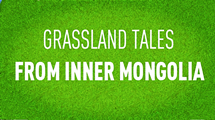Taking the reins of great change
By Wang Kaihao and Yang Fang (China Daily)
Updated: 2013-07-01

Chuluu oversees his horses in Bayantug. Ji Yuanxin / for China Daily
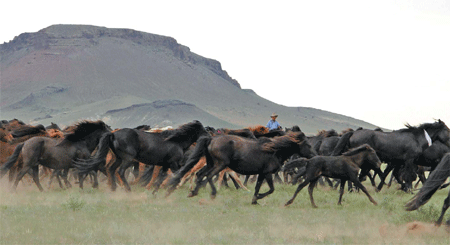
A herdsman drives horses close to Bogd Uul, a mountain regarded as holy by the locals in Abag. Saringovaa / for China Daily
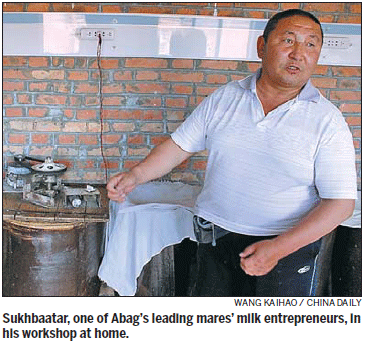

 |
|
Chuluu oversees his horses in Bayantug. Ji Yuanxin / for China Daily |
 |
|
A herdsman drives horses close to Bogd Uul, a mountain regarded as holy by the locals in Abag. Saringovaa / for China Daily |


Breeders witness ups and downs of trade in their beloved horses, report Wang Kaihao and Yang Fang from Abag Banner, Inner Mongolia.Inner Mongolia.
About 20 kilometers from the Sino-Mongolian border, yurts are scattered around the vast greenness of one of the best-known pasturelands in the region.
Qinglin, an ethnic Mongolian, will pack his yurts in a couple of days and move his horses to a nearby meadow in Abag Banner, the Inner Mongolia autonomous region.
Born into a family that raises the traditional breed of horse, known locally as khar adium, he doesn't know how many previous generations have followed the family trade. But the 45-year-old can't imagine life without the black horses.
Working several meadows with a combined area of around 1,200 hectares, Qinglin raises more than 100 black horses. Severe arthritis means he's unable to ride every day, but he stills rushes to take every opportunity to saddle up.
"Only a regular rider can possibly understand and raise these horses," he said.
After struggling for more than 20 minutes to put a saddle on an unbroken horse, Qinglin looked tired. Nevertheless, he said the work is easier than tending cattle and sheep, because horses have strong spirits.
Qinglin is one of Abag's 800-plus horse breeders and has witnessed the waxing and waning of the trade in his beloved steeds.
The khar adium, noted for its stamina and hardiness in winter, is one of four major traditional Mongolian horse breeds. In the 13th century, the ancient nomadic tribe of Abag was led by Belgutei, a half-brother of Genghis Khan, and according to local legend, the kharadium breed can be traced back to the warhorses of that time. Approximately 50 percent of the 30,000 horses raised in Abag today belong to the breed.
"It is purely for my love of horses," said Qinglin, lighting a cigarette and sighing, as he explained his vocation. His five siblings have all moved from the grasslands and now work in town.
"Tourists usually take it for granted that this is a hub for horses, but they may not know that horseback riding is not common nowadays," said Erdensang, Party chief of Bayantug Sumu, or township, the district's biggest horse center.
Modernity intrudes
He explained that the decline of horseback riding as a mode of transport is one of the main reasons for the downturn. Motorcycles and autos have become increasingly popular since the 1990s and although almost every local family raised horses in the old days, most shepherds now prefer to travel by modern methods.
"The climate also seems to have become drier," said Erdensang. "The grassland isn't flourishing as it did a few decades ago, and horses eat a lot of grass."
In 2012, the Abag government dug 41 wells to help the locals water their horses. Qinglin has to move his yurts around the meadow three or four times every year to help prevent the grasslands from becoming denuded.
Although the khar adium has a long history and a good bloodline, its high value has been ignored. Qinglin said the horses have even been sold for meat. Around a decade ago, one horse he sold for its meat fetched 3,000 yuan ($488).
Reviving the culture
The khar adium gained national fame in 1960 when the Abag Black Horse Company, a 120-person militia that patrolled the border, was granted a meeting with Chairman Mao Zedong in Beijing and was widely eulogized by the media.
The militia's glory was overshadowed by a decline in interest in raising horses, but the situation is not unique to Abag. In 1975, there were more than 2 million horses in Inner Mongolia, but their numbers had plummeted to less than 500,000 by the end of 2010, and fewer than 100,000 were pure breeds according to the Inner Mongolia Statistical Yearbooks.
Still, when Abag was named "The Hometown of khar adium" by the autonomous region's government in 2008, Qinglin cheered up. Abag launched an annual Khar Adium Cultural Festival in July, 2009, which attracts more than 30,000 visitors. The festival features demonstrations of lassoing skills, exhibitions, sporting competitions and even an equine beauty pageant. It's now the biggest arena for the promotion of the black horses in the area.
Horses owned by Hugjiltu, 43, another black-horse breeder in Bayantug Sumu, have taken the laurels at the beauty pageant for the last few years.
"The color must be pure," he said, revealing the secret of his success. "The body must be in good shape and strong, and of course, I also dress their manes carefully."
A climax of the festival is an endurance race. Children take the reins to minimize weight differences among the riders and fully reflect the horses' capabilities. The owner of the winning horse receives a prize. Although Hugjiltu's horses have also won this event, he always allows the child jockeys to take the cash.
"Honor is more important than money," he said, smiling.
He added that the event's presentations and performances, including dressing the manes, demonstrating branding marks and making harnesses, help keep these almost forgotten traditional skills alive. He keeps an elaborately decorated saddle in a glass cabinet at his home and never tires of explaining its unique Abag characteristics to visitors.
Abag's equestrian culture has also attracted national attention. It is listed by the China Photographers' Association as a "creative base for horse culture", and attracts 50 to 60 groups of photographers every year, according to Hunusut, the chief of Abag's Federation of Literary and Arts Circles.
"Traditions were restricted within individual families and gradually faded away," he said. "So it's great to revive people's love of horses through this combination with tourism."
Milking opportunities
The revival of the horse culture has been accompanied by an increase in business for related industries. In addition, the growing demand for racehorses has seen prices rocket in the past decade. Qinglin said that his racing horses sell for an average 30,000 yuan each, but his 20-plus mares constitute a bigger gold mine.
Every summer morning, he rises at 4 am to milk the mares. Each mare can produce 3.5 liters of milk per day. Each liter sells for about 25 yuan, but the price is often much higher at tourist hotspots. Qinglin earns more than 200,000 yuan per annum via this new, healthy drink.
Mares' milk is widely used in traditional Mongolian medicine and is believed to be especially effective in the treatment of tuberculosis, diabetes, and hypertension, according to Batbileg, the head of the Abag Hospital of Traditional Mongolian Medicine. The treatments were usually restricted to members of individual households, but Batbileg has experimented with introducing them into clinical treatment to "revive this crucial part of the ethnic group's culture".
Although mares' milk is growing in popularity, the pioneers of the trade once faced skepticism and, often, contempt.
"People from the Mongolian ethnic group use mares' milk to receive guests, and nobody made money from it at first," said Sukhbaatar, 51, one of the first people to sell the milk in Abag, recalling his early days in business during the 1990s. "I was despised, because traditionally merchants do not have high status in Mongolian culture.
"Nobody came to buy my milk, so I had to travel around Inner Mongolia to sell my produce," he said. Sukhbaatar has had rheumatoid arthritis since his 20s, meaning he is unable to undertake heavy labor. It was the main reason he began selling mares' milk. "Finally, this is a golden season for it."
He still uses the traditional fermentation method to make mares' milk yogurt at home, and although his output is too low to satisfy market demand, he prides himself on the high quality of his produce. The boom in business has seen him close his guesthouse and concentrate on his dairy.
"Only Abag has such good black-horse blood, and we have perfect conditions for producing fine mares' milk. We cannot afford to allow the value of this brand to decline," he said, referring to counterfeit mares' milk sold at the local market at a lower price.
In Abag, 58 families process mares' milk, producing 240 metric tons annually, according to the local agriculture and husbandry bureau. However, most of the producers are individual operations, so the banner is building a modern factory to combine their efforts and better maintain the freshness of the milk.
In spite of Abag's booming equestrian industry, a number of issues could hamper the gallop to a brighter future. A lack of financial support from the local government is a major problem.
"It's been four years since Abag first held the cultural festival, but horse breeders are generally inspired by praise rather than money," said Erdensang, the Party chief of Bayantug, barely hiding his disappointment. "Herders who raise sheep and cattle receive agricultural subsidies, but there are none for horse breeders."
Locals who buy black stallions for stud purposes receive 1,000 yuan per horse, but that's the only subsidy they receive. Abag's annual revenue is roughly 200 million yuan, one of the lowest among Inner Mongolia's banners and counties, which means the local government has little cash to spare for subsidies.
Chuluu, 66, is one of Bayantug's most experienced horse breeders. His horses always head the parade at the cultural festival, but even this great honor can't dispel the look of concern on his face
"Horses used to run wild on the grassland, but now they can only live within the wire fences and the limited space will result in inbreeding," he said.
The fences were erected in 1983 to mark the boundary of each family's meadow. Chuluu has considered introducing other types of horse to prevent inbreeding, but he is worried that new breeds will eventually result in fewer pure-blooded black horses.
He established the town's first breeding cooperative, involving eight families, in 2011. But after waiting in vain for more than two years for financial assistance promised by the government to expand their business, the cooperative's work has ceased.
"Abag has promised to build a public farm covering an area of 300,000 mu (20,000 hectares) and get more people involved," said Erdensang, who acted as an interpreter during the interview, with slight embarrassment.
Having originally imposed a quota to preserve the grasslands, the local government has now lifted the restriction on the number of horses allowed on each hectare of land to encourage the industry to develop.
Chuluu will not increase his herd, because a high-quality grassland is the basis of his livelihood and he respects the laws of nature.
"There are many black rocks in this area. I am a black rock who raises black horses," said the old man, whose name means "rock" in Mongolian. For once, he smiled: "Isn't that part of nature's plan?"
Contact the writers at wangkaihao@chinadaily.com.cn and yangfang@chinadaily.com.cn
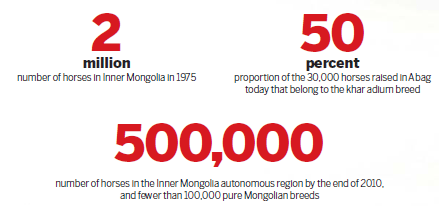
(China Daily 07/01/2013 page6)
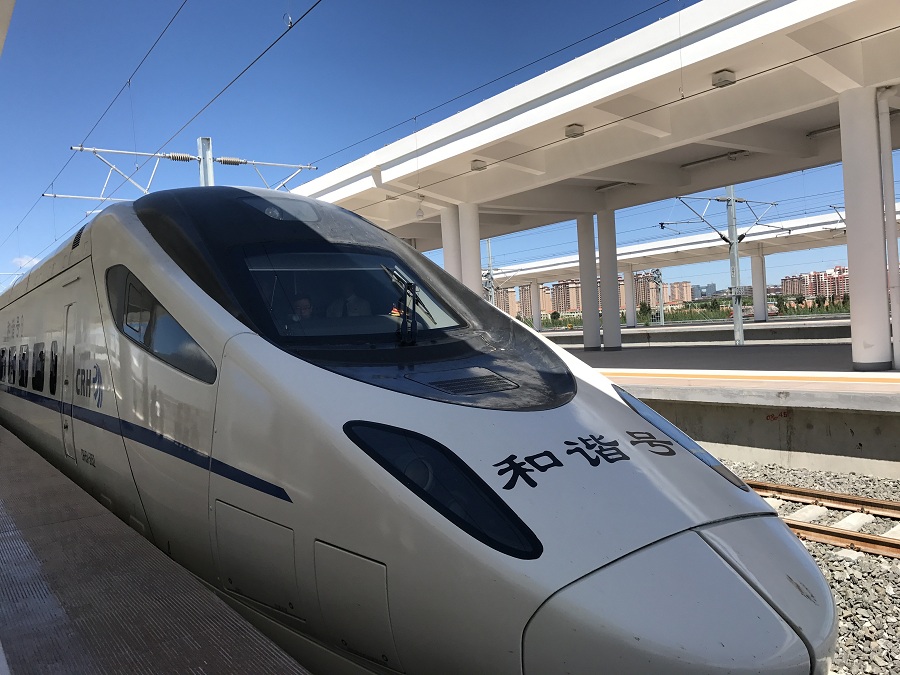
High-speed train debuts in Inner Mongolia
A bullet train departed Hohhot East Railway Station for Ulanqab marking the start of high-speed rail services using Inner Mongolia’s first newly-laid high-speed railway on Aug 3.
